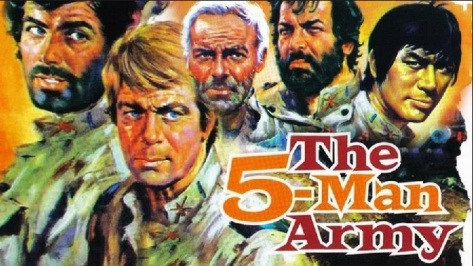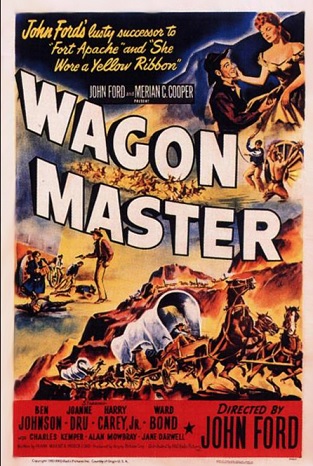 When I think of men-on-a-mission movies, I typically think of war movies, maybe some adventure and heist flicks among the bunch. I think of movies like The Guns of Navarone, The Dirty Dozen and Kelly’s Heroes among others. The best one though? Of all genres, it’s a western, and it’s a dandy. Maybe the perfect adventure movie, it’s 1966’s The Professionals.
When I think of men-on-a-mission movies, I typically think of war movies, maybe some adventure and heist flicks among the bunch. I think of movies like The Guns of Navarone, The Dirty Dozen and Kelly’s Heroes among others. The best one though? Of all genres, it’s a western, and it’s a dandy. Maybe the perfect adventure movie, it’s 1966’s The Professionals.
It’s 1917 and the Mexican Revolution is still raging strong all over the country. Along the U.S./Mexico border, four men, Rico Fardan (Lee Marvin), Bill Dolworth (Burt Lancaster), Hans Ehrengard (Robert Ryan) and Jake Sharp (Woody Strode), have been brought together to perform a dangerous mission. The little group, each of them a specialist in one way or another, has been hired by rancher and oil tycoon Joe Grant (Ralph Bellamy) to ride deep into Mexico and rescue his wife, Maria (Claudia Cardinale), who’s been kidnapped by a bandit and revolutionary, Jesus Raza (Jack Palance). Maria is believed to be stashed away in a hacienda in the mountains with Raza’s small army standing guard. This quartet is the best of the best with few equals, but even this job seems to be too much, especially if they haven’t been told the whole truth of what they’re riding into. Can they pull off the job?
One of Hollywood’s all-time best directors and writers, Richard Brooks earned 8 Oscar nominations over his distinguished career. He may have more respected movies, but ‘Professionals’ is easily his most fun and most entertaining (for me at least). It’s one of my favorites, and I always enjoy catching up with it. Mutually appreciated by both audiences and critics, ‘Professionals’ is one of the best westerns of the 1960’s and really, one of the best westerns of all-time. It picked up two Oscar nominations, one for Brooks’ directing and one for his script. Not a flaw in sight. Sit back and enjoy this one, hopefully with a big tub of popcorn.
Let’s get the boring technical stuff out of the way. Boring, but necessary. Brooks earned a Best Director nomination for blending a movie that features the technical, storytelling, characters, humor, action and visual look. With filming locations in the Valley of Fire, Death Valley, along with Nevada, California and Sonora, the visual appeal is evident. On the trail thanks to some key landmarks, you’re always aware of where you are. As well, the traveling and action scenes are aided immensely by composer Maurice Jarre‘s score, especially the main theme. Listen HERE. Throw it all together, and you feel like you’re right there with our Professionals in the sweaty, sun-baked desert where bandits and revolutionaries are there behind every rock waiting to ambush you.
The cast is pretty insane in terms of pure talent and star power, but with each repeated viewing, it always comes back to the script for me. Adapting a western novel called ‘A Mule for the Marquesa,’ Brooks transformed a good book into a great movie. This is a story that loves it characters, both the good and bad, and more importantly, knows them well. The script absolutely crackles, Lancaster and Marvin especially relishing delivering one memorable one-liner after another. I can’t think of too many westerns that have the ability to tread that fine line between serious action and a sense of humor. Read IMDB’s memorable quotes HERE. What’s impressive? Even out of context, they still can put a smile on your face, give you a good laugh. When you actually see Lancaster, Marvin and Co. deliver said lines? Oh my, you’re in for a treat.
I love a good men-on-a-mission movie, and this one belongs right at the top with The Magnificent Seven, The Guns of Navarone and The Dirty Dozen as my favorites. Seriously…Lancaster, Marvin, Ryan and Strode…oh, and Palance, Cardinale and Bellamy! That sound you hear is my head exploding from awesomeness. Brooks’ script introduces our characters with lightning-fast ease and we get to know them in that quick flash. Marvin’s Fardan is an ex-soldier, a leader, an organizer and a planner, Ryan’s Ehrengard a horse wrangler, a cowboy, Strode’s Jake an expert tracker/scout and specialist with bow and arrow, and last but not least, Lancaster’s Dolworth is a mercenary, a philosophizing dynamite expert. That is a ridiculously talented cast with a lousy script, but combined with Brooks’ script, the end result is some of the most memorable western characters ever with a story to boot. You can’t pass that up now, can you?!?
When I think of Burt Lancaster and Lee Marvin working together here, it puts a smile on my face. Their Bill Dolworth and Rico Fardan are the heart of the movie, mercenaries, soldiers and adventurers who are good friends who have worked together in the past, including previously in the Mexican Revolution. They too have a history with Palance’s Raza, making their job a touch more difficult. What the script and actors do so effortlessly is bring these characters to life. They’re tough, rough-hewn men who live by their word and their hard-fought ability to survive. They fight because they’re good at it, and maybe, just maybe, they like it a little bit. Their one-on-one scenes are some of the most memorable in the entire movie. When you throw the always reliable Robert Ryan and Woody Strode into the mix, you’re in for a treat.
Okay, we need an actor in the mid 1960’s to play a Mexican revolutionary….naturally, it’s Jack Palance! His Raza though is an underrated character, an equal to our Professionals, a somewhat disillusioned fighter who fights on because he loves Mexico, the people, and wants those in power out. Then there is Claudia Cardinale, maybe the most beautiful woman to ever grace the screen. Her Maria has some tricks up her sleeves as we’re introduced to her about halfway through. Bellamy is perfect in his part, beginning and end, as the worrying Joe Grant (or is he…). Also look for Jorge Martinez de Hoyos, Joe De Santis and Rafael Bertrand in key supporting parts. In a scene-stealing part, Marie Gomez plays Chiquita, one of Raza’s soldiers who has a history with Lancaster’s Bill.
What’s funny about ‘Professionals’ is that it isn’t an action-heavy story. Yes, there’s gunfights, chases and some memorable sequences, but it isn’t a 2-hour action scene. It’s the better for it. We get to know our characters really well in quick scenes featuring Brooks’ snappy dialogue. When the action does come, is it ever worth it, especially the pre-dawn attack on Raza’s hacienda deep in the mountains. Loud and chaotic, it is a gem. The other action is on a smaller-scale, tightly-edited firefights in claustrophobic canyons. So if there isn’t an overabundance of action, who cares? The general tone of the movie aids that cause. It’s not just a western. It’s also a buddy flick, a heist movie, a chase story, a love story, a history lesson of sorts, and with a bit of a twist mystery in the second half of a 117-minute feature film.
They don’t come along much better than this. One of those perfect action-adventure movies, one that’s hard to poke holes in. A phenomenal cast, a memorable script, and all you can ask for in a western. A true classic, for fans of the genre and even those who aren’t.
The Professionals (1966): ****/****


 One of the three members of the Alamo trinity along with David Crockett and William Travis,
One of the three members of the Alamo trinity along with David Crockett and William Travis,  The spaghetti western genre was built around the weird of the wild west, typically greedy gunfighters, murdering bandits and psychotic villains. How can you go wrong?!? Well, not all of the westerns. Made with backing from Italian and U.S. studios, here’s 1969’s
The spaghetti western genre was built around the weird of the wild west, typically greedy gunfighters, murdering bandits and psychotic villains. How can you go wrong?!? Well, not all of the westerns. Made with backing from Italian and U.S. studios, here’s 1969’s  In a legendary career that earned him eight Oscar nominations and two wins,
In a legendary career that earned him eight Oscar nominations and two wins,  The 1960s were the age of big budget war flicks, all-star casts leading the way in stories about World War II films. The most notable is The Longest Day – the telling of D-Day – but there were plenty more, including The Battle of the Bulge and today’s review, 1969’s
The 1960s were the age of big budget war flicks, all-star casts leading the way in stories about World War II films. The most notable is The Longest Day – the telling of D-Day – but there were plenty more, including The Battle of the Bulge and today’s review, 1969’s  A true Hollywood movie star,
A true Hollywood movie star,  When it comes to pure acting chops,
When it comes to pure acting chops,  Woody Strode
Woody Strode The late 1940s and early 1950s were undoubtedly
The late 1940s and early 1950s were undoubtedly